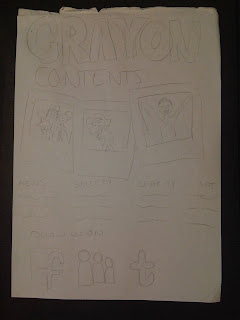Both Kerrang! and Xfactor magazine have a continuous colour scheme and font. Kerrang! uses the colours white, yellow and black give a rock type atmosphere. The font used has sharp edges and is very bold which may portray the audience of the magazine. Xfactor use a hot pink, black anf white colour scheme to give it a slightly more feminine look.
The generic music convention codes employed by Kerrang! magazine suggest the target audience are young (15-30 year olds), mostly male, people interested in rock. These people are the alternatives, they do not listen to pop (popular) music like most people do and are rebellious and different. This is why not only the masthead but the staplines are in distorted and different font. The font has a broken and shattered look which gives a sense of movement which goes well with the masthead of the magazine, Kerrang! as this word is very onomatopeic as a kerrang sound is the sound that would be made when struming a guitar, whereas the masthead of the Xfactor magazine is the very well known logo of the Xfactor TV show. Xfactor magazine appeals more to a very young (8-15 year old) audience that watch the very popular TV programme The XFactor and are interested in pop and very current music. These people are mainstreamers who like to follow trends and be current. This magazine also uses onomatopeia in the language used. The onomatopeia used in both magazines gives the magazines a sense of movement and excitement to engage the reader and give the magazine a lively atmosphere.
 The main image of Kerrang! is a low angle, midshot picture of a male playing a guitar and facing away from the camera and at the guitar. The picture being of a male is what tells us it is targeted at a male audience. A male will buy this magazine as they might aspire to be like him or look up to him, this is why the image is a low-angle shot so that the audience will literally look up to him. Also the man looking at the guitar instead of the camera shows us that the magazine is all about the music as even in the photo the focus is on the music.
The main image of Kerrang! is a low angle, midshot picture of a male playing a guitar and facing away from the camera and at the guitar. The picture being of a male is what tells us it is targeted at a male audience. A male will buy this magazine as they might aspire to be like him or look up to him, this is why the image is a low-angle shot so that the audience will literally look up to him. Also the man looking at the guitar instead of the camera shows us that the magazine is all about the music as even in the photo the focus is on the music.The main image in Xfactor magazine is a close-up of the 4 judges of Xfactor the TV programme. The picture of the judge, Cheryl Cole is the biggest picture and as it is a close-up this tells us that she herself is the main focus.









